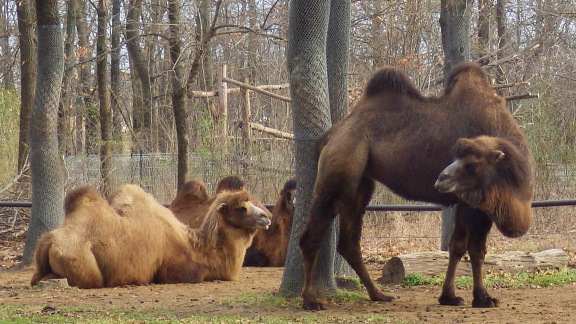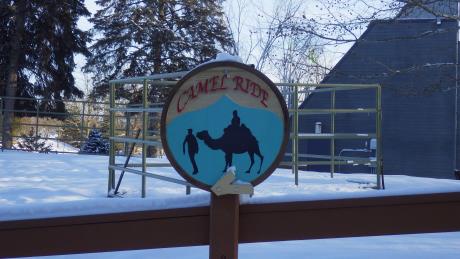Bactrian Camels are one of the extant two camel species (the dromedary being the other one).
The two can be easily distinguished because bactrian camels have two humps while dromedaries have only one.

Bactrian Camels (Camelus bactrianus) in the Szeged Zoo, Hungary.
Camels store fat in their humps, instead of getting fat all around which would act as an insulator against heat — not a good thing in the daytime in the desert. Camels can go for extended periods of time — several weeks — without food or water and they can withstand rather extreme environmental conditions from freezing cold to sweltering heat. If a camel has gone without water for a long time and then it gains access to water a camel can drink an enormous amount — some 57 litres have been reported — in a short period of time.
Most camels alive today are domesticated (both the bactrian and the dromedary kind) but a small population of wild (not feral) bactrian camels were discovered in the Gobi desert.
Apart from being used for riding camels have many other uses.
Camel hair can be used for making clothes. The hair of domestic bactrian camels is collected when they shed their winter coat in the spring, or by shearing a camel.
Camel milk is high in nutrients, and in many desert areas it is an important source of nutrition for humans where farming other dairy animals is impractical.
Camel meat is eaten in several countries. I personally never had any, so I cannot vouch for the taste.
Dry camel dung can be used as a fuel, especially in a desert where wood is hard to come by.
Camels can run quite fast — about as fast as a horse — but camels don’t trot, they pace (move the legs on the same side together). Perhaps this is why Hungarians compare riding a camel to a boat ride.
I wouldn’t know, I never rode a camel, although the Toronto Zoo offers camel rides, but those are really for children.
While there are only two extant species (although there is some debate if the wild and domesticated bactrian camels are to be considered one or two species) there were other extinct species of camel, one of them was a giant camel that looked sort of like a dromedary, and lived in the northern part of what is now Canada — camels do (or at least did) live under all sorts of extreme weather conditions.
Further Readings:
The Camel milk article on Wikipedia.
Bactrian Camel on the Toronto Zoo website.



